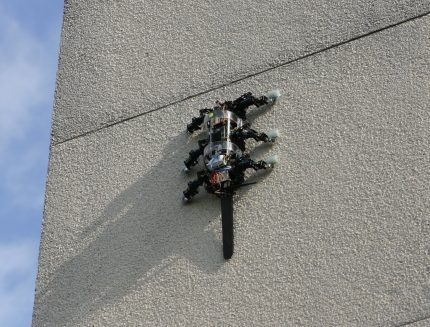in collaboration with Boston Dynamics, Inc., Stanford University, Carnegie Mellon University, U.C. Berkeley, and Lewis & Clark University

The goal of the RiSE project is to create a bioinspired climbing robot with the unique ability to walk on land and climb on vertical surfaces. Active research studies novel robot kinematics, precision-manufactured compliant feet and appendages, and advanced robot behaviors. This project is funded by the DARPA Biodynotics Program.
Our work within the Kod*lab on the RiSE project focuses on behavioral control of legged climbing, discovering how gait control methods can be applied for adverse scenarios in which feedback is a necessity in climbing. Combined with unique robotic mechanisms, our behavioral controllers have produced locomotion on a variety of outdoor climbing surfaces, such as trees, poles, stucco, and brick.
Robotic Platforms
- RiSE V1– the first generation prototype climbing machine
- RiSE V2 – a hexapedal climbing robot for general use on both level ground and vertical domains
- RiSE V3 – a quadrupedal climbing robot for rapid general outdoor climbing, as well as horizontal mobility
- DynoClimber – a testbed for dynamic climbing behaviors, two legs, operates on test carpet wall
- StickyBot – a testbed for dry adhesive panels, built by colleagues at Stanford University
- SpinyBot – a testbed for microspine arrays, built by colleagues at Stanford University
External links
- Boston Dynamics, Inc. – Industrial Collaborator
- Stanford University, BDML – Collaborator
- Carnegie Mellon University, Microdynamic Systems Laboratory – Collaborator
- U.C. Berkeley, Polypedal Laboratory – Collaborator
- U.C. Berkeley, Fearing Laboratory – Collaborator
- Lewis & Clark University, Autumn Lab – Collaborator
- DARPA Biodynotics Program – Sponsor
Media Appearances
2009
- Cutting-Edge Robots Show Off in Japan, MIT Technology Review, May 2009
- Beaver-tailed robot mimics tree-climbing insects, CNet News Military Tech, May 2009
- RiSE Robot Climbs Poles Like Some Sort of Ferocious Animal, Gizmodo, May 2009
- Boston Dynamics-designed RiSE V3 robot climbs poles, haunts dreams, Engadget, May 2009
- RiSE Version 3 climbing robot, Boing Boing, May 2009
- RiSE V3 Scrambles Up Telephone Poles Faster Than Ever, Bot Junkie, May 2009
- Video Friday: RiSE Walks, Runs, Bot Junkie, May 2009
2008
- RiSE Climbing Robot from Boston Dynamics, robots.net, August 2008
- RiSE climbing robot MAKE: Blog, August 2008
2006
- RISE Robot: Six-Legged BIODYNOTICS Runaway, Technovelgy.com, March 2006
- RiSE: Tree-Climbing Robot, Gizmodo, March 2006
2005
- Biologically inspired robot can walk, run, climb walls, and more, The Tartan Online, November 2005
Relevant Publications
2009
- Rapid Pole Climbing with a Quadrupedal Robot, ICRA, May 2009
2008
- Biologically Inspired Climbing with a Hexapedal Robot, Journal of Field Robotics, 2008
2006
- Gait Regulation and Feedback on a Robotic Climbing Hexapod, Robotics: Science & Systems II, August 2006
- Gait Generation and Control in a Climbing Hexapod Robot, SPIE Unmanned Systems Technology VIII, June 2006
- The RiSE Climbing Robot: Body and Leg Design, SPIE Unmanned Systems Technology VIII, June 2006
- Gaits and Gait Transitions for Legged Robots, ICRA, May 2006
2005
- Robotics in Scansorial Environments, SPIE Unmanned Ground Vehicle Technology VII, 2005
